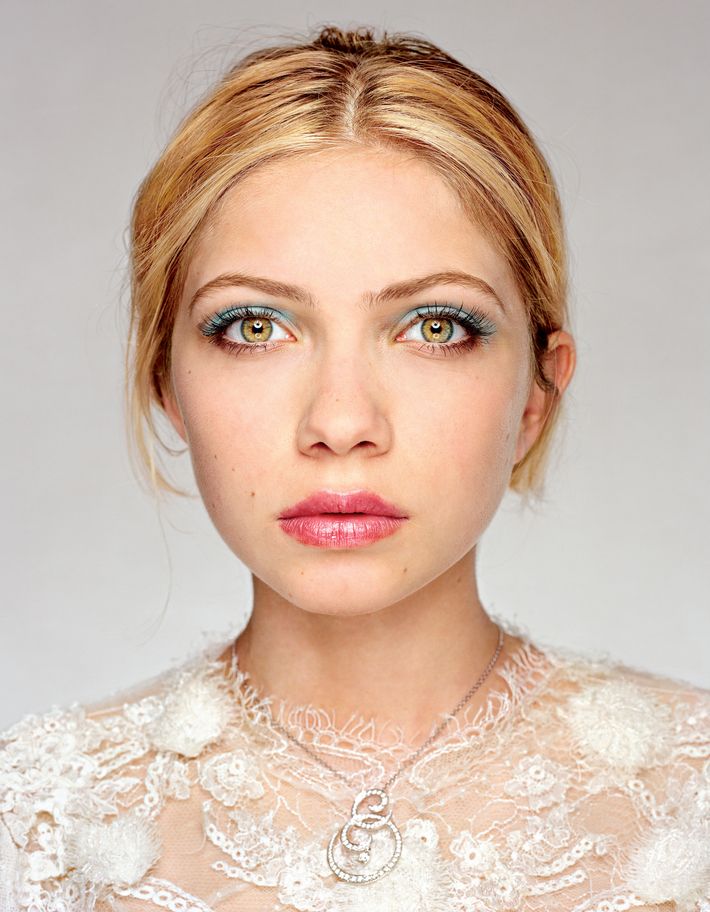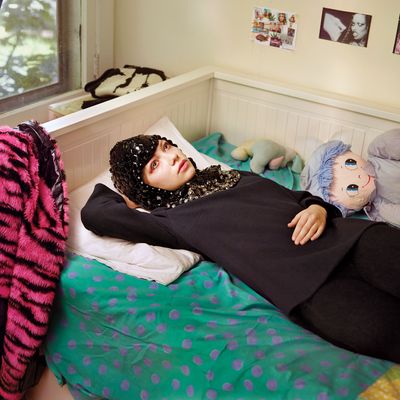
It has been seven weeks since Tavi Gevinson graduated from Oak Park and River Forest High School, and in that time she has moved from a tiny, cluttered bedroom with a single bed and a revolving collection of handwritten quotes and stylized ephemera at her parents’ suburban house to a studio apartment in a high-rise condominium in downtown Chicago that is paid for by the production team of This Is Our Youth, the Kenneth Lonergan play in which she is appearing with Kieran Culkin and Michael Cera. Rehearsals for the Steppenwolf leg of the show (previews on Broadway begin August 18) began before high school even ended, so perhaps the ending came a bit earlier than the day that she collected a diploma from her father (who is also her manager and the retired head of the English department at her school) and tweeted a photograph of herself in a white dress and a huge smile captioned: SCHOOL’S OUT FOREVER!
“I haven’t looked back,” Gevinson says. She is eating a bowl of cereal and a slice of toast in that apartment with its shiny parquet floors and stiffly corporate furniture that she has attempted to obscure with blankets and art books and pictures on the walls. Like most stage actresses, she wakes up late—her workday starts at 7 p.m.—and her hair is still damp from the shower. Her bed is neatly made following a sleepover with a high-school friend, and her books are neatly stacked. Taped above her desk are homages to Rainer Maria Rilke and Stevie Nicks.
It’s not that Gevinson didn’t like high school, she says. She liked the look of the place, with its big football field and boxy ’70s design: It made it easy to pretend that she wasn’t actually in high school at all, but rather living in a John Hughes movie, or on Freaks and Geeks. “That was definitely one of my most prominent coping mechanisms,” she says. She had wonderful friends—“the art kids who smoked” and played in punk-rock bands and had turquoise hair—and a sweet boyfriend, a first love she was able to land after the requisite heartbreak and “drama” of adolescence. (“I just needed to become stronger on my own, and then I was healthy and good and confident with myself.”) Mostly she liked it because it is that most universal of American rites of passage, a glue to bind her experiences to those of others who suffered the minuscule tragedies and triumphs of that hothouse microworld of hormones, nerves, and sticky-sweet illegal drinks. “I think everybody should go to high school,” she says. “It’s horrible, and it unites you with other people.”
That afternoon, during a nap, Tavi had a dream starring her ex-boyfriend. She woke up rattled, and she stayed rattled on the bumpy el ride to the theater, and through a fitting, and when she finally got into her dressing room and sat down in the quiet, she burst out in great big sloppy tears.
The next day we meet at the Adler Planetarium—a big dome jutting into Lake Michigan. She hasn’t been for years, but she suggests it because “sometimes, when you’re doing a magazine interview, it’s good to remember that you are not, actually, the center of the universe. Like, at all.”
She is pleased with her performance of the night before, one that earned a standing ovation. She thinks all the crying had something to do with it, she says, as space sounds ponggggg around her. “I think that when you make yourself vulnerable, the thing that you do next is better. It’s not like you have to inflict pain on yourself in order to make yourself better, but I think it helps. The thing that bonds you to a new friend isn’t that you went to a really fun party; it’s ’cause you had a really weird, sad conversation.” She starts to explain more, to clarify how aware she is that navel-gazing is a privilege, not a right, but the lights go down and a perky space guide begins narrating our journey through the galaxy. The narration is hokey, geared toward the many small children craning their necks. “This isn’t really for me,” Tavi says as she slinks down in her seat and plugs in the earphones of her iPhone. At quiet moments, muted bits of David Bowie emerge: “Space Oddity.”
As even casual prowlers of the internet worlds of fashion and style are aware, there’s been quite a lot in Gevinson’s life so far to separate her from her peers, from everyone, really, because she became famous at 11 years old, when a friend’s older sister told her about fashion bloggers and she began walking to a fancy bookshop that carried i-D and Lula magazines and taking pictures of herself in her backyard styled in the spirit of her hero, Rei Kawakubo of Comme des Garçons. When Kawakubo released a capsule collection at the mass retailer H&M while Tavi was in seventh grade, she wrote a nerdy rap tribute (“Rei Kawakubo for H&M / Rei Kawakubo, can I be your friend? / Rei Kawakubo, stalker fan letters I will send …”) and posted it online. The indie queen Miranda July saw it and showed it to her friends Laura and Kate Mulleavy, who design the art-fashion brand Rodarte, and then everyone saw it. Gevinson was flown (with her father) to London to make a zine for Pop magazine, but then Dasha Zhukova, at the time the editor of Pop, liked her style—which, at that point, was an avant-garde-granny kind of thing—so much that she ended up on the cover. Next she was in New York at a Fashion Week party at the Gagosian Gallery while Cindy Sherman complimented her self-portraits and Björk wandered by and then Richard Prince did too. But she was also overhearing catty fashion jerks make fun of her prepubescent androgyny (“Is that a girl or a boy?”) as she settled into her front-row seat and realized, at 13, that the fashion world wasn’t so different from middle school after all. Still, at the end of that first Fashion Week, she sat in the departures lounge at La Guardia airport and cried. “I was like, This is it. I got this one cool experience, and now I’m back to middle school, where I was made fun of for what I wore. I’m sure I wasn’t the most pleasant classmate. I was very opinionated, and I was just discovering riot grrrls.”
By 14, she was pretty much over the fashion world. She was more interested in the riot-grrrls part of things than the what-she-was-wearing part—the way it felt to be mocked, to cry in class, to show the mean boys her swollen eyes and assess their guilt, even if she was carrying a secret pocket of confidence that she describes as “Well, Iris Apfel liked my outfit.”
That first Fashion Week wasn’t it, of course. Gevinson kept getting opportunities and invitations, and at a talk at the Ideascity conference, she expressed interest in making an online magazine in the spirit of Sassy—there could be fashion of the sort she likes, which is to say dress-up fantasies and the use of clothing as a means of self-expression, but mostly there would be essays and interviews and general chat for girls who felt like she had felt in middle school—curious about the world and yet alone, isolated in their own small, suburban bedrooms aching over The Virgin Suicides. Jane Pratt, the founding editor of Sassy and the current editor of xoJane, got in touch and said, “Well, why not?” And Tavi posted on her blog that she was looking for contributors for this new venture, which would be called Rookie, after her blog. She received 3,000 responses; one was from Anaheed Alani, a 40-year-old woman who was working as a fact-checker at The New York Times Magazine. “I hadn’t met her in person,” Alani says, “but we were email friends. I was just a superfan of hers. I found her writing and her sense of humor and her outlook on the world to be exciting, really smart, and I kind of couldn’t get enough of it. When I first saw her blog, I sat there for five hours and read it all and then emailed all of my friends and said: ‘This is an emergency. You all have to read this. This girl is 12 years old, and her brain is this crazy little alchemizer of ideas.’ ”
Alani said she’d gladly quit her job to join Rookie, and so she, Pratt, and Gevinson got to work. But they quickly realized that they were scarily naïve where business matters are concerned. Alani’s husband, the radio host Ira Glass, got involved, and Gevinson decided that she would remain as independent as possible, being very careful about her revenue sources—no advertising she didn’t believe in. She eventually parted ways (amicably) with Pratt and now has a full staff working remotely from their homes—Alani, a managing editor, and three part-time story editors. “She’s taught me a lot,” Alani says, “especially about being a boss. Maybe it’s because she has no experience of how people work in hierarchies. Tavi’s very straightforward. It might just be because she was 14 at the time.”
A week before Tavi’s 16th birthday, a trio of Hollywood agents invited her to dinner in Oak Park. They wanted Tavi to have resources, they explained to her and her dad. There was no limit to what she could do: write screenplays (she’s been typing up pieces of her journals lately, because you never know), or inspire others with the peculiarities of her most singular of lives. Gevinson’s parents had always been supportive, as they are of all three of their daughters. (Rivkah, the eldest, is an artist living in Berlin. Miriam has just graduated from the University of Wisconsin with a degree in psychology.) But they are a relaxed family with a slightly hippie vibe—Steve Gevinson grew up Orthodox in Silver Spring, Maryland, and worked as an English teacher for his entire career. He met Tavi’s mother, Berit Engen, on the final day of his graduate studies abroad in Oslo, and soon they were driving around America in a VW Rabbit. Engen converted to Judaism and is a weaver who renders scenes from the Torah in Scandinavian linen yarn.
“Normally we’re really skeptical of anything like that, like, they wouldn’t really get anything I was doing,” Tavi recalls about the dinner. “But halfway through the meeting, I was thinking, Why don’t I feel weird? Are they just really charming? But they were great. I asked them if I could start seeing some scripts, and they said okay, because they didn’t know that I did acting.”
But Gevinson does act, and has always done so, since before she knew about Japanese deconstructionist fashion. Gevinson and her two older sisters were stalwarts of local community theater—she was Gavroche in Les Miz. And before the outside world consumed her too fully, she hung around with the high-school theater clique, singing in both the choir and an a cappella group. “I no longer get into stupid thought wormholes about identity and stuff,” she explains. “At one time I did have some impostor syndrome about acting, but then I remembered I’ve been doing this since I was little, actually.” The summer before her junior year, Tavi filmed Enough Said, holding her own in scenes with Julia Louis-Dreyfus. The role in This Is Our Youth was something she wanted desperately—it was a role she felt she understood. It was, after all, about a young woman hoping to make sense of the world. She put herself on tape, then flew to New York for a callback in front of the casting director, as well as Lonergan and producer Scott Rudin, neither of whom is a regular reader of her blog. She got the role in part because of her newness, and it’s been helpful that many of the people for whom she auditions don’t know about her odd celebrity. “I said to my goddaughter, ‘She’s such a great dresser!’ ” says Anna D. Shapiro, the show’s director, “and she said, ‘What are you, a caveman?’ ”
There is a kindness to Tavi. This comes across in the way she interacts with her readers, in her ability to let Rookie be a virtual happy place for the girls who use it as a forum, often, to discuss their sadness, like the reader named Anya who posted a comment on a story that read, “I know this has nothing to do with the article but I’m really depressed right now.” Tavi messaged her right away and invited her to see This Is Our Youth and stayed after the show to meet her and chat.
It’s a play that deals with angst, depression, loneliness, and beginnings. It’s mostly about boys—rich Manhattan boys in the ’80s for whom drugs and insults are the principal currencies of life. But there is one girl in it—Jessica. She is smart but protected and afraid. And she manages to talk herself out of something that might actually become intimate and nice.
Jessica keeps saying the wrong thing. She’s prickly, and in Tavi’s hands it’s heartbreaking rather than nasty. “Kenny said most girls just play her as a bitch, and in the beginning I think I was playing her that way, but then I started discovering her layers.”
It’s been a meta-adolescence. Tavi has enacted a camera-ready high-school life, one in which her fashion experimentations looked fantastic rather than just ill-fitting and strange, and the whole thing was seen as a lark, hilarity worth preserving. She’s been adopted by the pop intelligentsia, who perhaps see in her a younger version of themselves, either real or idealized and imagined. Zadie Smith, whom she met after speaking at The New Yorker Festival, wrote her an email urging her not to skip college, and Stevie Nicks, whom Tavi met after mentioning her in a TED talk, gave her a cashmere blanket to wrap herself in whenever she felt like she needed a hug. Ask her if she’ll miss being a teenager and she says, “I will try to hold on to the intense feeling. I will both be glad that that’s no longer happening and kind of miss it. When you’re 14, you’re basically on drugs all the time—the hormones in your body are so crazy. But I really loved and appreciated the intensity of that. And you’re experiencing everything for the first time, so everything feels like an epiphany. And, like, I really liked the experience of having a crush, because I was like, this is my thing and it doesn’t have to do with you and you’re just some dummy boy for me to project on.”
To be observing the experience of a teenager while in the midst of living it is an unusual thing. She’ll mention a summer afternoon when she and her friend and their sisters sat on a couch and watched a 25-hour television marathon that included all parts of the Shrek series, then point out that this occurred not long after a trip to Paris when she met Karl Lagerfeld, and a full year after she flew to Antwerp to cut the ribbon at an exhibition of Stephen Jones’s work at the MoMu museum. She counts the sitcoms she’d watch as a kid among her cultural touchstones—King of the Hill, The King of Queens—and says she uses them to connect to an older generation.
In anticipation of everything new, she broke up with her boyfriend “totally out of love and respect. You can’t stay with your high-school sweetheart forever,” she says. “People do, but you shouldn’t.” They’d broken up once before, but it didn’t stick. “I flew straight to New York for a wedding,” she says, “and then I visited Taylor Swift at her home in Rhode Island. I hate being heartbroken, but who better to discuss it with than Taylor Swift?” Next was a visit to her friend Lena Dunham on the set of Girls, then it was back to Oak Park, where she and the boyfriend reunited. But it didn’t last. This summer’s enforced breakup was important, she feels, for getting her future going. “I had some time in Oak Park to reclaim everything that had happened in my life thus far as my own,” she says. “And actually, coming out of the breakup has kind of reignited my love for fashion, because it’s a way of asserting a new identity and becoming a new person and giving yourself space.”
She is, finally, ready for whatever is going to happen in her life from here on, and to graduate from Freaks and Geeks. “My roommate and I say it’s going to be like Last Days of Disco, except we’re both the nice one.” When This Is Our Youth opens on Broadway, Tavi will move to New York as a working adult with three Hollywood agents and a Lower East Side apartment shared with her best friend, a 21-year-old photographer named Petra Collins who is so close that when Tavi lost her virginity, she asked Collins to take pictures of her the next day, thinking it was worth documenting photographically. She plans to enroll at NYU in 2015. She’ll be spotted at Whole Foods on the Bowery; she’ll find herself in taxis with rich New York kids who argue over directions with drivers; she’ll be at lots of parties and movies; and she will be watched for signs of change—any deviation from the “authentic Tavi” will surely be noted.
“Every time I’m like, What if I go to New York and I get caught up and I become a horrible person? But then I’m also like, I’m about to discover a lot of things about myself, like this poem I have on my wall. The last lines are: ‘You have not grown old and it is not too late to dive into your increasing depths where life calmly gives out its own secret.’ And that’s something that I repeated to myself a lot after the breakup and that I think about a lot whenever I feel like being a teenager is so much of who I am and I get nervous, and then it’s like, No. Things are just beginning.”
Gevinson creates mood boards for her life. “I’m a big journaler,” she explains, “so for every new journal I would change the way my room looked and change the posters on the walls and I would change what I was wearing and I would have a playlist, and it all kind of corresponded and matched, and I would change my handwriting in the journals.” It was, in many ways, an acting exercise, but also a constant experiment in selfhood, the kind of thing lots of teenagers do, albeit generally in a less organized fashion. Right now, she’s into pastels and the movie Clueless. She’s not exactly sure what that means. Yet.
But then, all of a sudden, she is just a regular teenager again. Toward the end of the play’s run at Steppenwolf, Lonergan flew to Chicago to check in on his work. After the show, Cera and Gevinson joined him for dinner. “It’s just so refreshing to see a pretty young woman order cheese,” Lonergan says of Tavi. Over all that cheese, Lonergan and Gevinson got into an argument about Beyoncé that Cera summed up as, Is Beyoncé the standard-bearer for mediocrity (Lonergan) or an important cultural figure (Gevinson)? “She likes to argue and so do I,” says Lonergan, “and she’s really smart and so am I, so you end up having these discussions about interesting and broad-ranging topics. But then I find it very charming that she’ll go from mentioning a talk she gave in Australia at 16 to complaining about ‘Why does my dad care if I go to bed late?’ Or how annoying it is that her best friend is in Costa Rica and she can’t text her.”
In the original version of Mary Poppins, there is a heartbreaking chapter about a pair of infant twins. As babies, they speak to a starling, and they understand what the wind whispers to the cherry trees on its way back up into the sky. The babies swear that they’ll never be the adults who coo ridiculously at their bedsides, oblivious to the language of the flowers and bees. But, of course, they do forget, and they do grow up to use condescending words for things too beautiful for speech.
One of the most affecting moments in This Is Our Youth is a speech Jessica makes about memory, about the possibility that these kids will forget the deep feelings they have for things—songs, pictures, colors, each other.
JESSICA: … Everything you think will be different, and the way you act, and all your most passionately held beliefs are all gonna be completely different, and it’s really depressing.
WARREN: How do you figure?
JESSICA: Because it just basically invalidates whoever you are right now. You know what I mean? It just makes your whole self at any given point in your life seem so completely dismissible. So it’s like, what is the point? […]
It’s like when you find an old letter you wrote that you don’t remember writing. And it’s got all these thoughts and opinions in it that you don’t remember having, and it’s written to somebody you don’t even remember having ever written a letter to.
WARREN: I’ve never found a letter like that.
JESSICA: Well I have. Like, a lot of them. And it just makes you realize that there’s just these huge swaths of time in your life that didn’t register at all, and that you might just as well have been dead during them for all the difference they make to you now.
But Tavi has it all down; there will be nothing to forget. As she grows up, she can study the pictures from the day after her virginity was lost, seeking traces of something in her eyes. She can read the words she wrote on discovering that the combination of contact lenses and puberty was serving her well and that she’d grown up to be, well, beautiful. “I didn’t want to post this photo because I look good in it,” she wrote one summer day in 2011. “And, as someone whose ‘thing’ for so long has been ‘Challenge beauty standards! Screw convention! Look like a grandmother on ecstasy at Fashion Week!’ that somehow felt hypocritical.”
She worked it out, in the end, with hundreds of comments from her readers who have been watching it all, too, looking for themselves in her words and, more often than not, finding what they were looking for.
*This article appears in the August 11, 2014, issue of New York Magazine.
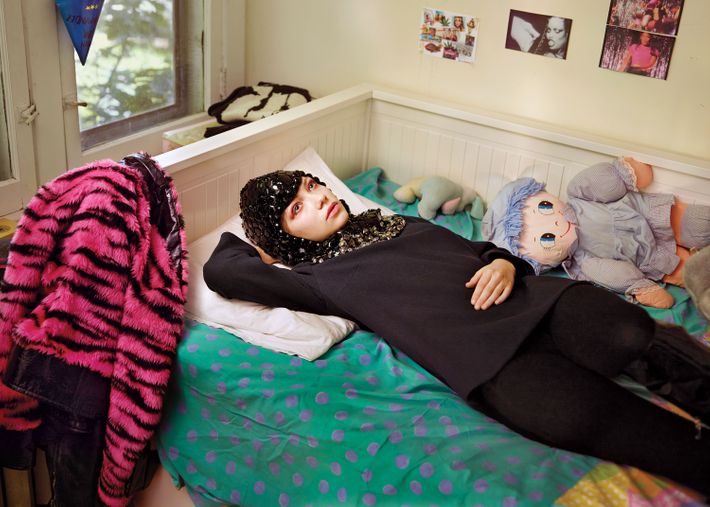
Gevinson in her childhood bedroom.
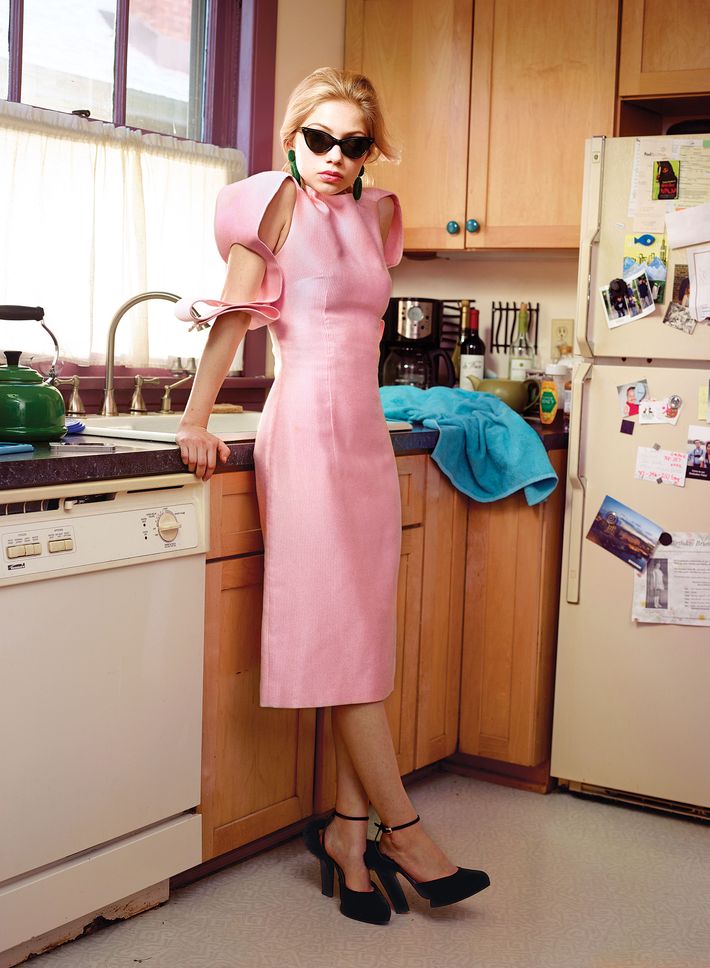
Gevinson in her parents’ kitchen.
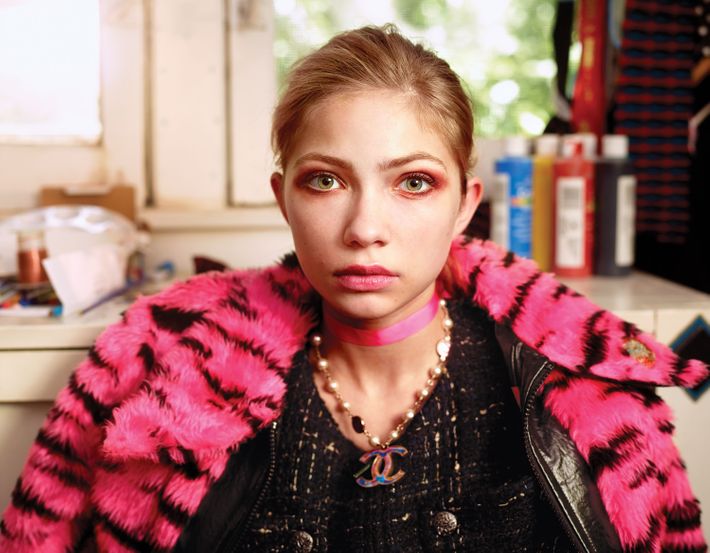
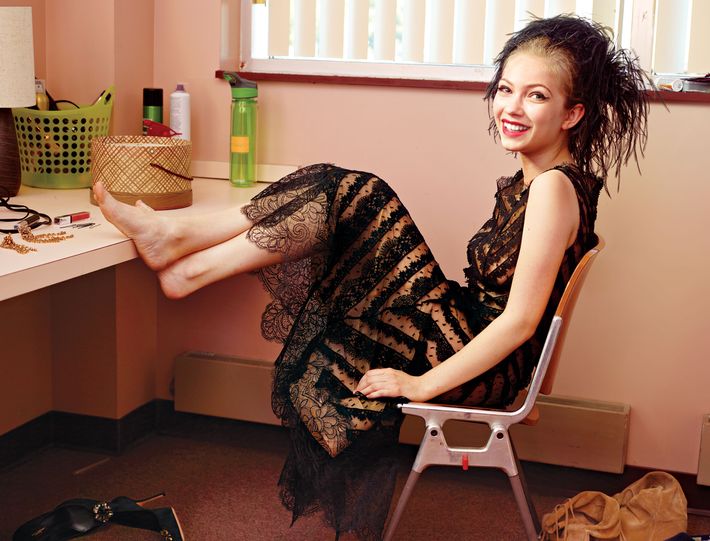
Gevinson backstage at the Steppenwolf Theatre in Chicago.
